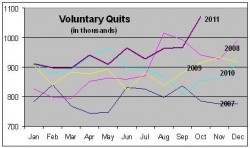 Whether a sign of confidence or desperation, the number of workers quitting without having another job is growing. Last month alone nearly 1.1 million workers left their jobs.
Whether a sign of confidence or desperation, the number of workers quitting without having another job is growing. Last month alone nearly 1.1 million workers left their jobs.
It’s the largest number of “job-leavers,” as the U.S. Bureau of Labor Statistics calls them, in more than a decade. Included in the count are workers who took buyouts, some who quit ahead of a dismissal, and others who may be taking time off before starting a new job. The bulk, however, are those who decided to leave a job without having another lined up.
There’s no way of telling what kind of workers these job-leavers are. However, any number of surveys over the last few years show there’s a gathering wave of intentions about leaving, if not actual departures.
“Top performers have had it with stagnant opportunities and rewards, and are starting to jump ship now that the job market is a bit looser,” says Dr. Pat Sikor, TNS Employee Insights Senior Researcher. Pointing to declining scores on employee engagement surveys, she says it “reflects the pent-up demand of employees to want more than what they have.”
TNS Employee Insights conducts surveys and research into the effect of employee engagement on business performance. Its recent research shows a dramatic drop in some key measures of engagement. Between 2006 and 2011, TNS found a 17.6 percent reduction in employees who feel their company rewards them according to the value of their performance. There has been a nearly 13 percent decline in their feelings about the company when it comes to personal development and growth.
Other surveys have found similar results. What this suggests is that employees are disengaging, with most choosing not to become job-leavers, but ready to bolt should an opportunity come along.
BlessingWhite, which conducts a periodic broad, global study of engagement, found last year that 13 percent of North American workers planned to leave their current job in a year. That was almost twice the 7 percent who planned to quit in the 2008 survey. While workers were about as engaged last year as in 2008 (57 percent v. 56 percent), the less engaged the worker, the more likely they said they were to leave. Older workers were more likely to be engaged; millennials, the least engaged.
Disengaged and disengaging workers aren’t necessarily minimum performers. There is a correlation between engagement and performance, as the BlessingWhite report details. However, for any number of reasons (many of them referenced in these reports), top performers can grow disenchanted.
Why did workers want to leave? The BlessingWhite survey found 28 percent of North Americans cited lack of career opportunities. That was also an area where the TNS Employee Insights survey saw a decline from 2006. In the 2010 survey, worker satisfaction with career opportunities within their current company had declined 14.3 percent; 48 percent said they were satisfied in the most recent survey.
With the economic malaise continuing and job creation barely keeping up with population growth, most workers aren’t too likely to simply walk out the door with no place to go, although obviously tens of thousands do. Fewer will go out in Joey style, producing a video of his musical resignation seen now by 3 million. But top talent that grows disenchanted has opportunities. Whether they call that headhunter who left them a message or put out the word to their network, they will find another job.
However, as TNS’ Sikor says, “The key to retaining top talent therefore is simple: move the needle and increase employee engagement.” She’ll be one of the speakers at a free TNS webinar on Dec. 6 — “How to Retain Top Talent – Moving the Needle in Employee Engagement,” which is HRCI approved.